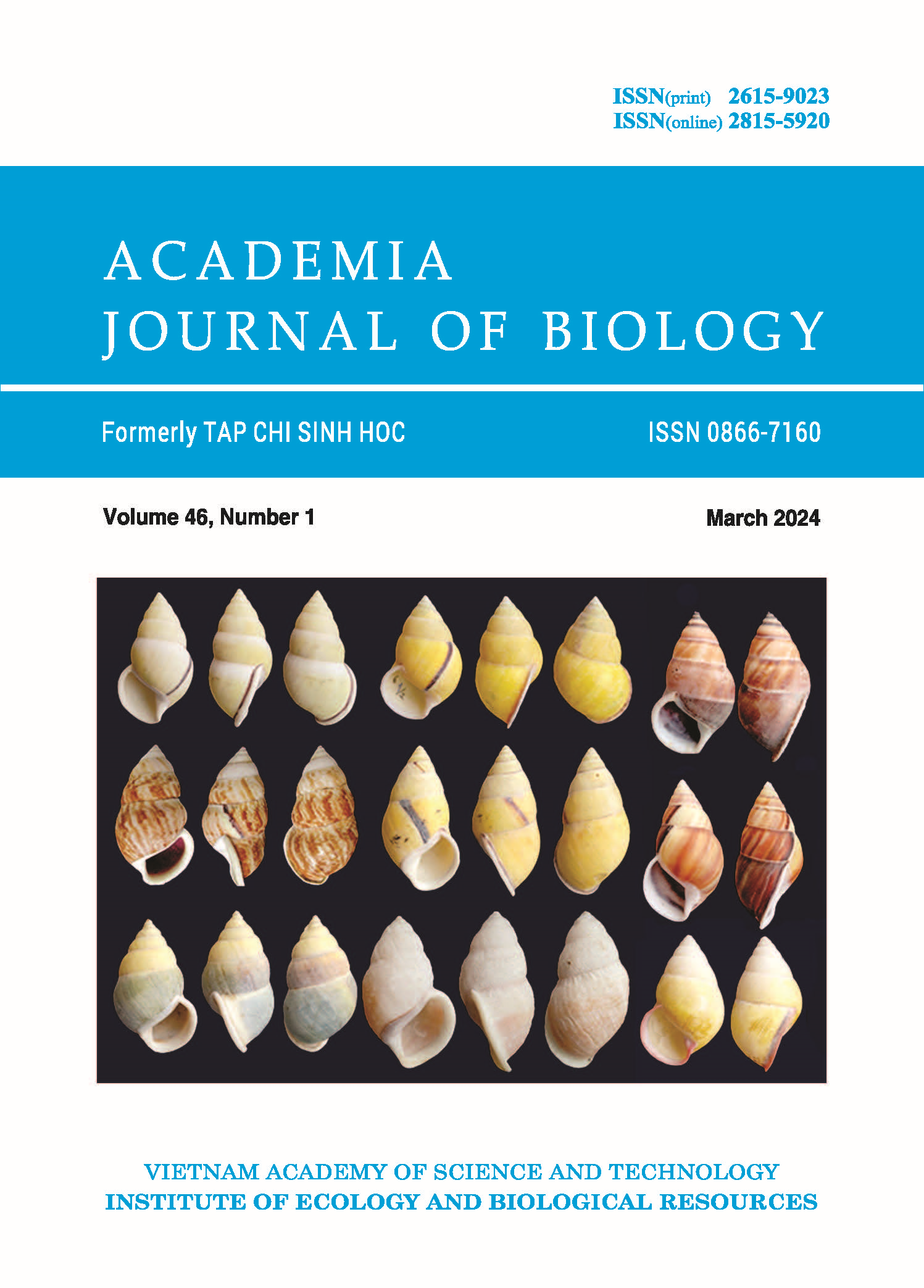Roosting and nesting ecology of house sparrow (\(\textit{Passer domesticus}\)) in Guwahati city, Assam
Author affiliations
DOI:
https://doi.org/10.15625/2615-9023/19265Keywords:
Roosting, Guwahati city, Brahmaputra River, Nests, Solitary.Abstract
Aves are unique in having a coat of feathers and in balancing on the hind limbs alone. They are known as the feathered bipeds. Roosting, nest building in birds has been considered a remarkable behaviour in aves. The nesting ecology of birds is likely the most important component of its life history and it is affected by several ecological and environmental factors. Guwahati city, a rapidly growing city in northeast India inhabits a lot of species of birds. It is located between the Brahmaputra River’s southern bank and the Shillong plateau’s foothills. Total of the 57 nests, 28% were discovered in the rolling shop shutters, followed by 27% in the tin sheet roofs of homes, followed by 19% in building crevices, 9% in building holes, 7% in advertisement hoarding and 5% in AC outdoor units and 5% in unused building pipes. It is also observed that 49% of the nests are located at a height between 2–4 metres from the ground level, 70% of the nests are located between 1–5 metres from the nearest food source, and 58% of the nests are located between 1–5 metres from the nearest water source. Out of the 57 nests observed, 50 were found to be solitary, 5 were found to be Pair, and 2 were found to be cluster type. The study found that choosing a nest is influenced directly by the location of the nearest food source and nearest water source in Guwahati city. The study presents the merit and needs for studying the nesting ecology of birds in India, also suggests best practices to conserve bird’s nest specific to the Indian context which might provide important information for the nesting ecology of House Sparrows (Passer domesticus).
Downloads
Metrics
References
Ali S. and Ripley S. D., 1983. Handbook of the birds of India and Pakistan, compact ed. New Delhi: Oxford University Press, pp. 737.
Anderson T., 2007. Biology of the Ubiquitous House Sparrow: From Genes to Populations. Biology of the Ubiquitous House Sparrow: From Genes to Populations: 1–560.
Cink C. L., 1976. The influence of early learning on nest site selection in the House Sparrow. Condor, 78: 103–104.
Daniels R. J. R., 2008. Can we save the sparrow?. Current Science, 95(11): 1527–1578.
Heij C. J., 1986. Nests of House Sparrow, Passer domesticus; composition and occupants. International Studies on Sparrows, 13(1): 28–34.
Kurhade S., Kshirsagar J., Magh P., Kasar R., 2013. Habitat wise distribution of house sparrow (Passer domesticus indicus) in Parner tehsil of Ahmednagar district, Maharashtra, India. European Journal of Experimental Biology, 3(4): 194–197.
Laet J. D. and Summers - Smith J. D., 2007. The status of the urban house sparrow Passer domesticus in north-western Europe: a review. Journal of Ornithology, 148(2): 275–278.
McKenny M. L., 2002. Urbanization, biodiversity and conservation. BioScience, 52: 883–890.
Miller S. G., Knight R. L., and Miller C. K., 1998. Influence of recreational trails on breeding bird communities. Ecological Application, 8: 162–169.
Modak Biplob, 2015. Impact of Urbanization on House Sparrow Distribution: A Case Study from Greater Kolkata, India. Proceedings of the Zoological Society: 70.
Nath A., Singha H., Deb P., 2015. Nesting in a Crowd: Response of House Sparrow Towards Proximity to Spatial Cues in Commercial Zones of Guwahati City. Proc Zool Soc, 69: 249–254.
Rajashekar S. and Venkatesha M. G., 2008. Occurrence of House Sparrow, Passer domesticus indicus in and around Bangalore. Current Science, 94: 446–449.
Robinson R. A., Siriwardena G. M. and Crick H. Q. P., 2005. Status and population trends of Starling Sturnus vulgaris in Great Britain. Bird Study, 52(3): 252–260.
Summers-Smith J. D., 1963. The House Sparrow. London: Collins, pp. 269.
Summers-Smith J. D., 2003. The decline of house sparrow: a review. British Birds, 96: 438–536.
Sundaramoorthy T., 2007. House Sparrows - An indicator species of environmental change. Eco News, 13(1): 8–9.
Yasue M. and Dearden P., 2006. The potential impact of tourism development on habitat availability and productivity of Malaysian plovers. Charadriusperonii. Journal of Applied Ecology, 43: 978–989.
Downloads
Published
How to Cite
Issue
Section
License
Copyright (c) 2024 Snigdha Pegu, Sudipta Nag, Rubaiya Hasan, Arup Nama Das

This work is licensed under a Creative Commons Attribution-ShareAlike 4.0 International License.












